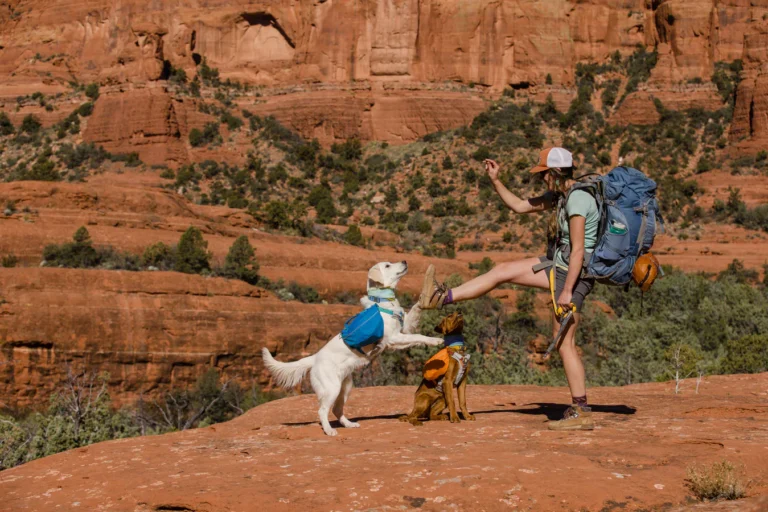Many dog owners aspire to take their furry companions on longer hiking adventures, but building your dog’s endurance safely is crucial for both their health and enjoyment. Transitioning your dog to more intense outdoor activities requires a strategic approach to ensure they can handle the increased physical demands. This guide will provide you with practical tips and techniques to help your dog develop stamina over time, allowing for enjoyable and safe hiking experiences together.
Key Takeaways:
- Gradually increase the duration and intensity of hikes to build your dog’s stamina.
- Incorporate regular short walks and intervals of play to enhance overall fitness.
- Monitor hydration and rest breaks to ensure your dog stays comfortable and safe during hikes.
Understanding Your Dog’s Current Fitness Level
Assessing your dog’s fitness is important before launching on longer hikes. Evaluate their activity levels, current exercise routine, and overall health. A few weeks of sustained activity, like daily walks or fetch games, can help you gauge their baseline fitness. Consider factors like age, breed, and any pre-existing health issues, as these can significantly affect your dog’s ability to handle increased demands.
Evaluating Endurance
To evaluate your dog’s endurance, start with shorter hikes and observe how they handle the terrain and distance. Track their pace, energy levels, and behavior during and after the activity. Gradually increase the length and difficulty of these walks, ensuring your dog remains eager and engaged rather than fatigued. Tailor your expectations based on your dog’s individual capabilities, always prioritizing a gradual progression.
Signs of Fatigue
Being aware of signs of fatigue is important for your dog’s safety during hikes. Watch for excessive panting, lagging behind, reluctance to continue, sudden changes in behavior, or seeking shady spots. A dog that lies down or seems uninterested in treats may be indicating they need a break. If you notice these signs, it’s time to pause, hydrate, and allow them to rest before continuing.
Signs of fatigue can manifest in various ways. Heavy panting and drooling are often early indicators that your dog is overexerting itself. Monitor their movements closely; if your dog slows down or starts to lag, this may be a signal of exhaustion. Some dogs may even show signs of distress by whining or refusing to walk further. Keeping a close eye on these behaviors allows you to address fatigue before it leads to more serious health issues, ensuring a safe and enjoyable adventure for both of you.
Factors That Influence Endurance Building
Several elements impact how effectively you can build your dog’s endurance. These include genetics, current fitness level, training methods, and environmental factors. Each dog is unique, and understanding these factors will help tailor your approach to suit your furry companion’s needs.
- Genetics and breed
- Current fitness level
- Training consistency
- Environment and weather conditions
Perceiving these factors allows you to implement a customized regimen that optimally boosts your dog’s endurance.
Breed Considerations
Certain breeds naturally possess higher endurance levels, such as working dogs like Siberian Huskies or Labrador Retrievers. In contrast, brachycephalic breeds like Bulldogs may struggle with prolonged activity due to their respiratory constraints. Understanding your dog’s breed is imperative for setting realistic endurance expectations.
Age and Health Status
Your dog’s age and overall health dictate their capacity for endurance training. Senior dogs may require a gentler approach, while younger, healthier dogs can typically handle more rigorous exercise. Always consult with your veterinarian before starting a new fitness program to ensure it is safe and appropriate for your dog’s specific conditions.
Older dogs often experience joint stiffness or other health issues that can impede endurance building. Conversely, young dogs, especially those with high energy levels, tend to adapt quickly to exercise regimens. Nonetheless, both age groups need gradual conditioning to prevent injury. Carefully monitor weight and vital signs; regular veterinary check-ups will help you gauge your dog’s readiness for increased physical activity.
Developing a Training Plan
A structured training plan is vital for enhancing your dog’s endurance effectively and safely. This plan should take into account your dog’s current fitness level, age, and any health conditions. Aim for a mix of different types of exercises throughout the week to keep things engaging and balanced. Regularly assess your dog’s progress and adjust the plan accordingly to ensure they are challenged yet not overwhelmed.
Gradual Increase in Distance
Begin by gradually increasing the distance of your walks or hikes. Start with short, manageable routes that match your dog’s fitness level and slowly extend these journeys as they build stamina. For example, if they are comfortable with one mile, increase by a quarter of a mile each week until reaching your target distance.
Incorporating Interval Training
Interval training involves alternating between periods of intense activity and rest. This approach not only boosts endurance but also enhances your dog’s overall fitness. For example, you could walk briskly for five minutes, then allow your dog to trot at a relaxed pace for another five minutes, repeating this cycle multiple times during a session.
To make the most of interval training, use a timed approach. Start with a 20-minute session, alternating between 5 minutes of brisk walking or trotting and 5 minutes of walking at a slower pace. This method keeps your dog engaged and helps to build cardiovascular strength. As your dog adapts, you can increase the intensity and duration of the fast intervals to further enhance their endurance over time, ensuring you’re progressing at a safe and effective rate. Tracking their performance can also provide insight into how they’re responding to the training regimen.
Tips for Safe Hiking with Your Dog
Before hitting the trails with your dog, ensure both of you are prepared for a safe and enjoyable experience. Follow these tips to optimize your outing:
- Choose dog-friendly trails
- Keep your dog leashed in crowded areas
- Observe park regulations regarding dogs
- Watch for signs of fatigue in your dog
- Carry a first-aid kit for emergencies
Knowing these guidelines helps prevent mishaps and ensures a positive experience for both you and your dog.
Appropriate Gear and Supplies
Selecting the right gear is necessary for your hiking adventure. Invest in a durable leash, a comfortable harness, and a reflective collar for visibility. Consider using booties for your dog to protect their paws from rough terrain and extreme temperatures. A backpack designed for dogs can help distribute their gear and keep them engaged during the hike.
Hydration and Nutrition
Maintaining your dog’s hydration and nutrition is vital during hikes. Bring along collapsible water bowls and ensure your dog has access to fresh water throughout the day. Pack high-energy treats or dog food to sustain their energy levels, especially on longer hikes.
Aim for roughly one cup of water per 20 pounds of your dog’s weight for every hour of activity, adjusting for conditions like heat or altitude. Dehydration can lead to fatigue, so offer water every 15-30 minutes based on your dog’s activity level. Nutritional snacks such as trail mix tailored for dogs will help replenish energy stores and keep their spirits high, especially during extended outings.
Monitoring Your Dog During Hikes
Staying attentive to your dog’s condition while hiking is vital for ensuring their safety and well-being. Regularly check their behavior, energy levels, and physical signs throughout the hike. Look for any signs of fatigue, dehydration, or distress, and be prepared to adapt your plans accordingly. Having a keen eye for changes can prevent potential injuries or complications and make your hiking experience enjoyable for both of you.
Recognizing Warning Signs
Awareness of your dog’s body language and behavior is key to spotting warning signs. Signs of overexertion include excessive panting, lagging behind, reluctance to move, or unusual stiffness. If you notice any of these signs, it’s time to assess their condition and consider taking breaks or adjusting your hike’s intensity.
Adjusting On-The-Fly
Being flexible during your hike allows you to adapt to your dog’s needs in real-time. Recognize when your original plan may need to change based on your dog’s performance. If they show signs of tiredness, plan shorter intervals, increased hydration breaks, or even cut the hike short to avoid overexertion.
For example, if you initially planned a two-hour trek and your dog starts lagging after the first hour, switch to a shorter loop back to the trailhead. Carrying portable water bowls and high-energy treats can help rejuvenate your dog quickly. Adjusting your pace can also benefit you—slow down to match your dog’s comfortable speed, ensuring they enjoy the hike without stress. Do not forget, keeping a flexible mindset is vital for a successful hike with your furry companion.
Adding Variety to Your Training
Incorporating variety into your dog’s training is vital for keeping them engaged and motivated. Introduce new activities such as agility training, swimming, or even fetch on different terrains. Each activity offers unique challenges that engage your dog’s mental and physical capabilities. Additionally, consider rotating locations for your training sessions. These changes will not only build endurance but also keep your dog excited about their exercise routine. For more tips on keeping your dog safe during hikes, check out How Can I Keep My Dog Safe While Hiking in Central ….
Different Terrain and Environments
Expose your dog to various terrains during training to develop their adaptability and strength. Switching from flat paths to hills, rocky surfaces, or sandy areas can challenge their balance and coordination. Each type of terrain exercises different muscle groups, enhancing overall endurance. If possible, take advantage of local parks or nature reserves that offer diverse environments.
Socializing with Other Dogs
Socialization plays a significant role in your dog’s overall training regimen. Allowing your dog to interact with other canines while training enhances their confidence and reduces anxiety. Scheduled playdates or group training sessions can facilitate these interactions, promoting healthy behaviors. The exposure helps them become accustomed to pacing alongside their peers, ultimately benefiting their endurance and social skills.
Engaging with other dogs not only provides vital social experiences, but it also encourages physical activity. Playful interactions can lead to increased running, jumping, and overall movement, which contributes to building your dog’s stamina. Aim for opportunities where your dog can play off-leash in a safe, fenced area. These sessions often mimic the wild, providing natural motivation for your dog to keep going and adjusting to different paces alongside their furry friends.
To wrap up
From above, building your dog’s endurance for longer hikes requires a gradual approach that prioritizes safety and well-being. Start with short, consistent walks, gradually increase the distance, and incorporate varied terrains to keep your pup engaged. Pay attention to your dog’s behavior and energy levels, ensuring they stay hydrated and take breaks as needed. With patience and careful planning, you can enhance your dog’s stamina, making every hiking adventure enjoyable and safe for both of you.
FAQ
Q: What is the best way to gradually increase my dog’s endurance for longer hikes?
A: Start with shorter distances and gradually increase the length of your hikes by 10-20% each week. Incorporate rest days to allow your dog to recover and adapt. Monitor your dog’s energy levels and adjust the pace accordingly.
Q: How can I tell if my dog is ready for longer hikes?
A: Look for signs of fatigue such as heavy panting, lagging behind, or reluctance to continue. Ensure your dog can comfortably handle shorter hikes before attempting longer ones. Regularly assess their behavior and physical condition during and after hikes.
Q: Are there specific exercises that help build my dog’s endurance?
A: Include activities like running, swimming, and playing fetch to build stamina. Hiking on varied terrain can also improve muscle strength and endurance. Consider adding interval training by alternating between walking and jogging during walks.





